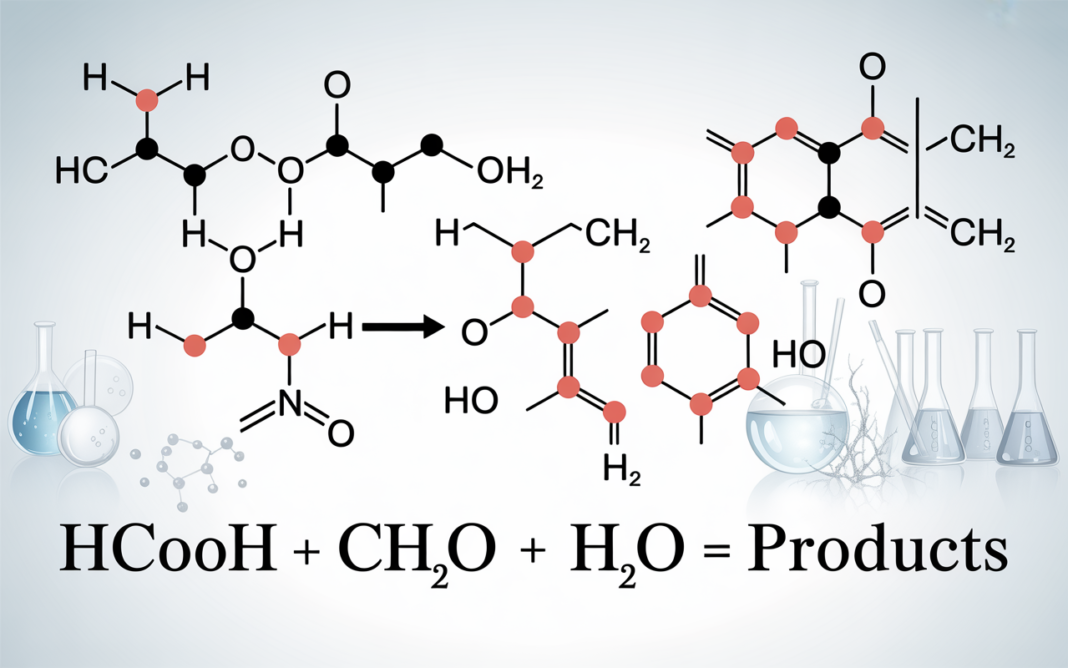Introduction: Unlocking the Chemistry of HCOOCH CH2 H2O
Chemistry often fascinates us with its intricate reactions and unseen molecular transformations. Among the countless reactions studied in organic chemistry, the HCOOCH CH2 H2O reaction holds special importance due to its role in ester formation, hydrolysis, and organic synthesis. Understanding this reaction provides insight into how compounds interact with water, acids, or bases to form new substances with significant industrial and biological value.
In this detailed exploration, we’ll uncover what the HCOOCH CH2 H2O compound represents, how the reaction occurs, the mechanistic steps, factors affecting the process, and its real-world applications across multiple scientific and industrial domains.
By the end of this article, you’ll have a clear and comprehensive understanding of the science behind the HCOOCH CH2 H2O reaction process — from molecular theory to practical use.
1. Understanding the Chemical Formula: What is HCOOCH CH2 H2O?
To decode the HCOOCH CH2 H2O reaction, we must first understand what this chemical formula implies.
Breaking it down:
-
HCOO– represents a formate group, derived from formic acid (HCOOH).
-
CH or CH2 units typically indicate carbon–hydrogen linkages found in organic molecules, such as aldehydes or alcohols.
-
H2O represents water, a universal solvent and participant in many hydrolysis and condensation reactions.
When combined, HCOOCH CH2 H2O represents a reaction between a formate ester and water (or an esterification/hydrolysis equilibrium). The process depends on the reaction direction:
-
In esterification, water is removed to form an ester.
-
In hydrolysis, water is added to break an ester back into an acid and an alcohol.
Thus, the HCOOCH CH2 H2O reaction can symbolize the formation or decomposition of a formate ester, depending on environmental conditions and catalysts.
2. The Basic Reaction Mechanism
The HCOOCH CH2 H2O reaction process typically involves ester hydrolysis or esterification, depending on the catalyst (acidic or basic) and conditions (temperature, concentration).
Here’s how it can be represented in general form:
HCOOCH2R+H2O⇌HCOOH+HOCH2RHCOOCH_2R + H_2O ⇌ HCOOH + HOCH_2R
Where:
-
HCOOCH2R = A formate ester
-
HCOOH = Formic acid
-
HOCH2R = Alcohol produced after hydrolysis
In this reversible reaction:
-
When water reacts with the ester, hydrolysis occurs.
-
When formic acid reacts with an alcohol, esterification occurs.
This duality makes the HCOOCH CH2 H2O system a perfect model for studying reaction kinetics, equilibrium, and thermodynamics in organic chemistry.
3. Step-by-Step Breakdown of the Reaction
Let’s analyze the acid-catalyzed hydrolysis pathway of the HCOOCH CH2 H2O reaction:
Step 1: Protonation of the Ester
The carbonyl oxygen in the ester molecule becomes protonated by the acid catalyst (like H⁺). This increases the electrophilicity of the carbonyl carbon, making it more reactive toward nucleophiles.
HCOOCH2R+H+→HCOOH+CH2RHCOOCH_2R + H^+ → HCOOH^+CH_2R
Step 2: Nucleophilic Attack by Water
Water, acting as a nucleophile, attacks the carbonyl carbon. This forms a tetrahedral intermediate — an unstable structure where the oxygen is bonded to both hydrogen and the carbonyl carbon.
HCOOH+CH2R+H2O→[HCO(OH)OCH2R]+HCOOH^+CH_2R + H_2O → [HCO(OH)OCH_2R]^+
Step 3: Proton Transfers
Internal proton transfers occur to stabilize the intermediate. This step helps in reorganizing the molecule for bond cleavage.
Step 4: Cleavage of the Ester Bond
The oxygen–carbon bond between the formate group and the alkoxy group breaks, releasing the alcohol (HOCH2R) and forming formic acid (HCOOH).
[HCO(OH)OCH2R]+→HCOOH+HOCH2R+H+[HCO(OH)OCH_2R]^+ → HCOOH + HOCH_2R + H^+
Step 5: Regeneration of Catalyst
The acid catalyst (H⁺) is regenerated at the end of the reaction, confirming that it functions purely as a facilitator.
In summary:
HCOOCH2R+H2O→H+HeatHCOOH+HOCH2RHCOOCH_2R + H_2O \xrightarrow[H^+]{Heat} HCOOH + HOCH_2R
This is the hydrolysis pathway. The reverse reaction, esterification, occurs when formic acid reacts with alcohol under dehydrating conditions (removal of water).
4. The Role of Water (H2O) in the Reaction
Water plays a dual role in the HCOOCH CH2 H2O reaction process:
-
As a Reactant (Hydrolysis):
Water directly participates in breaking the ester bond, donating hydroxyl and hydrogen ions that reform the acid and alcohol. -
As a Solvent:
Water helps stabilize ions and intermediates, lowers activation energy, and maintains equilibrium during the reaction.
The amount and temperature of water also determine the reaction’s direction — high water concentration favors hydrolysis, while low water content favors esterification.
5. Catalysts That Influence the Reaction
Catalysts are essential in driving the HCOOCH CH2 H2O reaction efficiently.
1. Acid Catalysts
-
Common examples: H₂SO₄ (sulfuric acid), HCl, H₃PO₄.
-
Function: Protonate carbonyl oxygen and increase reactivity.
-
Application: Preferred in industrial ester hydrolysis and synthesis.
2. Base Catalysts
-
Common examples: NaOH, KOH, Na₂CO₃.
-
Function: Generate hydroxide ions (OH⁻), which attack the ester carbonyl carbon.
-
Product: Instead of regenerating acid, the base forms formate salt (HCOONa) and alcohol.
HCOOCH2R+NaOH→HCOONa+HOCH2RHCOOCH_2R + NaOH → HCOONa + HOCH_2R
3. Enzymatic Catalysts
-
Enzymes like lipases can catalyze esterification or hydrolysis under mild conditions.
-
Eco-friendly and highly specific, suitable for biochemical and pharmaceutical synthesis.
6. Factors Affecting the HCOOCH CH2 H2O Reaction
Several parameters determine how effectively the HCOOCH CH2 H2O reaction proceeds:
A. Temperature
Higher temperatures accelerate both esterification and hydrolysis by increasing molecular kinetic energy. However, excessive heat may cause unwanted side reactions or product decomposition.
B. Catalyst Concentration
An optimal catalyst level ensures maximum conversion without over-acidification or base degradation.
C. Water Concentration
Water shifts the equilibrium.
-
More water → favors hydrolysis
-
Less water → favors esterification
D. pH Level
Acidic conditions enhance ester formation, while basic conditions promote hydrolysis.
E. Reaction Time
Longer reaction times ensure complete equilibrium but may affect yield depending on the reversibility.
7. Energy Profile and Reaction Kinetics
The HCOOCH CH2 H2O reaction process exhibits a typical activation energy curve:
-
A high initial energy barrier (for bond breaking).
-
A lower energy state once the transition state stabilizes via proton transfers.
Kinetically, the reaction follows first-order or pseudo-first-order kinetics, depending on water concentration. Advanced computational chemistry models (like Density Functional Theory, DFT) are used to simulate the energy transitions and predict reaction rates.
8. Industrial and Practical Applications
The HCOOCH CH2 H2O reaction has several valuable applications in organic synthesis, environmental chemistry, and industrial production.
1. Ester Production
Formate esters derived from this reaction are key intermediates in producing:
-
Perfumes and flavors
-
Plasticizers and solvents
-
Biodegradable materials
2. Fuel Industry
Formate esters can be used as additives in fuels, improving combustion efficiency and reducing emissions.
3. Pharmaceutical Synthesis
Hydrolysis and esterification pathways are essential for synthesizing prodrugs, active pharmaceutical ingredients (APIs), and intermediates.
4. Environmental Chemistry
Hydrolysis reactions help in biodegradation of pollutants and detoxification of organic waste materials.
5. Laboratory Applications
This reaction is a standard example in academic labs to demonstrate reaction equilibrium, kinetics, and catalysis principles.
9. Theoretical Importance in Organic Chemistry
The HCOOCH CH2 H2O reaction is often used to illustrate:
-
Reversibility of reactions in chemical equilibrium.
-
Catalyst role in modifying activation energy.
-
Hydrolysis vs. esterification balance in organic systems.
It serves as a model system for understanding biochemical pathways (like lipid metabolism), where ester bonds continuously form and break under enzymatic control.
10. Environmental and Sustainability Perspective
Modern chemistry emphasizes green and sustainable reactions. The HCOOCH CH2 H2O system fits perfectly within eco-friendly parameters because:
-
It can occur under mild, aqueous conditions.
-
Uses biocatalysts (like enzymes) instead of harsh acids or bases.
-
Produces non-toxic by-products (formic acid and alcohol).
This makes it suitable for green chemistry and biochemical applications where sustainability is a priority.
11. Challenges and Limitations
Despite its usefulness, the HCOOCH CH2 H2O reaction faces a few limitations:
-
The equilibrium can be hard to shift completely toward one side.
-
High purity of reactants and precise control of pH are necessary.
-
Industrial scalability requires energy optimization and waste management.
Ongoing research focuses on heterogeneous catalysts, microwave-assisted systems, and ultrasound reactors to improve efficiency and minimize energy usage.
12. Modern Innovations and Research Trends
Recent studies on HCOOCH CH2 H2O reactions explore:
-
Nanocatalysts: Using metal-oxide nanoparticles to enhance reaction rate.
-
Biocatalysis: Employing engineered enzymes for selective transformations.
-
Computational Modeling: Predicting energy barriers and transition states.
-
Renewable Feedstocks: Producing esters from biomass or waste materials.
These advancements are turning traditional organic reactions into smart, sustainable processes that align with global environmental goals.
13. Real-World Example: Laboratory Demonstration
In a controlled lab environment:
-
Mix formic acid (HCOOH) with ethanol (CH3CH2OH).
-
Add a few drops of sulfuric acid (H2SO4) as a catalyst.
-
Heat gently under reflux.
-
Remove water as it forms to drive esterification forward.
The result: Ethyl formate (HCOOCH2CH3) — a fruity-smelling ester used in flavoring.
This demonstrates how the HCOOCH CH2 H2O reaction process operates in practice.
14. Future Outlook
With growing demand for renewable materials and efficient chemical synthesis, the study of reactions like HCOOCH CH2 H2O will continue to expand.
Emerging technologies — such as AI-assisted reaction modeling, green solvents, and energy-efficient reactors — promise to make these processes faster, cleaner, and more sustainable.
Future research aims to:
-
Optimize reaction kinetics via real-time AI prediction models.
-
Reduce energy consumption using microwave and photochemical methods.
-
Replace fossil-based reactants with bio-derived compounds.
Conclusion: The Chemical Harmony of HCOOCH CH2 H2O
The HCOOCH CH2 H2O reaction process beautifully demonstrates the balance between chemistry, energy, and environment.
At its essence, it’s not just a reaction—it’s a molecular conversation between water and organic molecules, showing how matter continuously transforms and adapts.
From producing fragrances and fuels to guiding sustainable chemistry innovations, the HCOOCH CH2 H2O reaction bridges the gap between theory and real-world impact.


